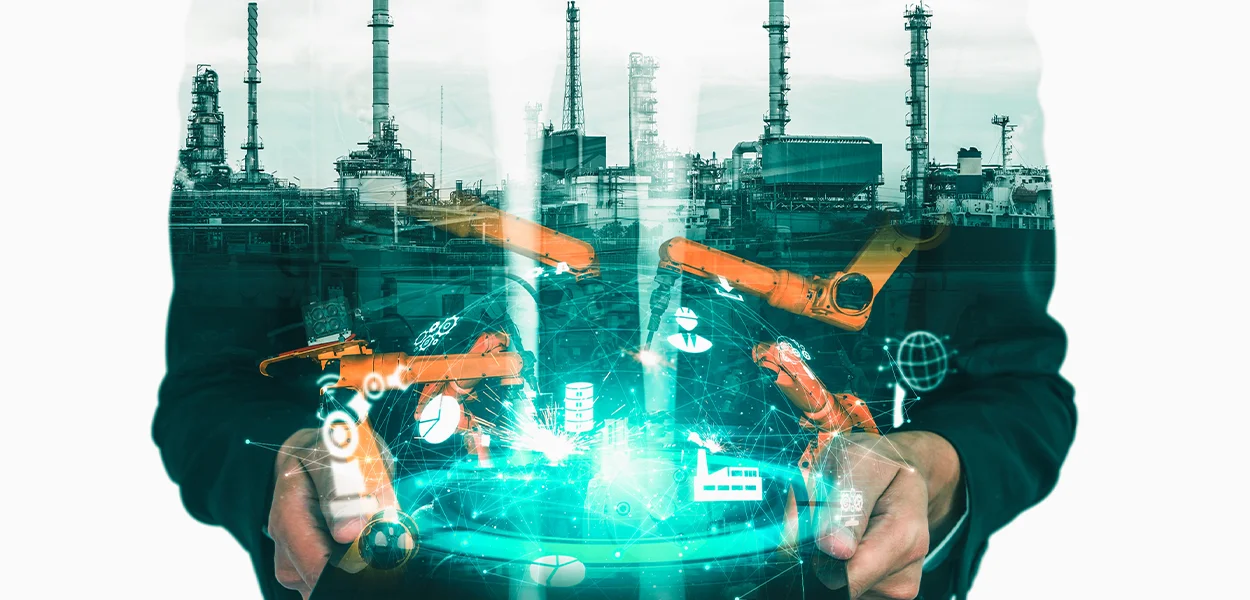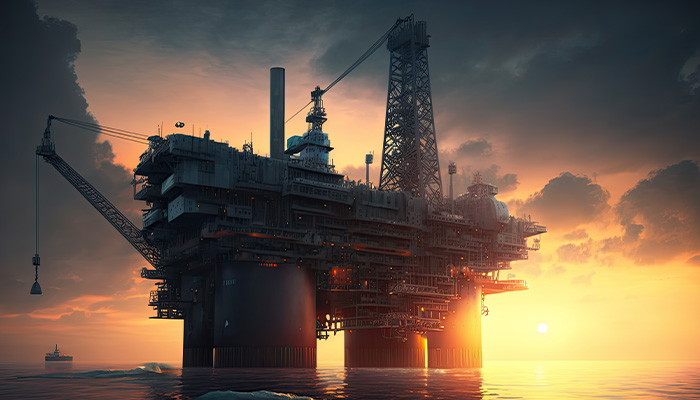5 Best Use Cases of AI in the Oil and Gas Industry
5 Best Use Cases of AI in the Oil and Gas Industry
Sept 1, 2023 12:47PM
5 Best Use Cases of AI in the Oil and Gas Industry
Sept 1, 2023 12:47PM

AI is a revolutionary technology. It has the power to transform the way we live, work, and think. AI is used by businesses in many ways to improve efficiency and productivity.
This blog will examine how AI is used in the oil and gas industry and the potential benefits for businesses. We will also examine some factors to consider when planning an AI project for use in an oil and gas business.
Oil and gas is a capital-intensive and complex industry. The oil and gas industry involves the exploration, production, refinement, and marketing of petroleum products. Due to its environmental impact, the sector is subject to strict regulations.
The oil and gas sector has faced increasing pressure in recent years to meet global demand while coping with rising costs and decreasing reserves. In response, the oil and gas industry has turned to AI.
Artificial intelligence in oil and gas, which is becoming more prevalent in the oil and gas industry, has proven to be an essential enabler of projects for various applications. They include reducing maintenance costs and downtime by predicting equipment failures, improving modeling capabilities, and understanding reservoirs to enhance operational efficiency.
AI is a powerful tool that helps companies in the oil industry make faster and better decisions.
Organizations in this sector increasingly use AI to increase their productivity and profits, whether they are drilling for oil or gas or engaged in transportation or drilling activities.
In the oil and gas sector, identifying defects or improper threading of pipelines is one of the biggest challenges. The cost of defects found in the final stages of production due to issues upstream is a burden on budgets and factories. If, for example, a defective oil pipeline or machine was installed in production, it could cause severe damage. These losses are far greater than the costs of AI adoption.
A computer vision-based system can verify the quality and give deep insights into defects. AI-powered defect detection solutions are highly cost-effective in comparison with existing processes.
Oil and gas plants operate in more dangerous environments than traditional manufacturing ones. Oil plant employees work at different temperatures and are exposed to toxic fumes. They must also be aware of a variety of moving mechanisms. Injuries and financial penalties can be incurred if you do not follow safety protocols. Two employees were burned by sulfuric acid at the Tesoro Martinez Refinery, based in California. Officials at Tesoro described the incident and said it could have been avoided if employees had followed safety standards.
The law requires that companies adhere to safety standards. Non-compliance with these standards can result in heavy fines. Although much data is available to monitor safety, the process is still mostly manual, like manually checking camera feeds or doing physical safety checks to ensure effective measures. The current solutions ensure that employees wear personal protection equipment (PPE), but only at the entry point into the plant.
A computer-vision solution powered by AI can monitor a worksite to ensure workers follow safety procedures. The data from the camera is fed into an AI algorithm, which will analyse it and send alerts. AI solutions can alert management to even the slightest deviations from compliance.
The oil or gas rig extract is stored in a central repository and transported through pipelines. Oil and gas components are often affected by corrosion and material degradation due to different temperatures and environmental conditions. Corrosion may cause the component's deformation, resulting in faded threads or weakening the pipeline. This problem, if not addressed, can cause catastrophic damage and stop the production process. It is a significant concern for the industry, and many companies hire corrosion engineers to monitor the components and prevent corrosion.
Take the Macondo Incident, also known as the BP Oil Spill. On April 20, 2010, 4.9 million barrels of oil were spilled, and $850 million was spent on cleanup efforts by the US government. This was one of the largest oil and gas spills. Research reports based on post-analysis concluded that the incorrect maintenance function was a significant cause of the incident. Checking the equipment's condition was part of the maintenance requirements. The emergency system had been disconnected and was not working.
AI solutions can prevent such incidents. AI and IoT can detect corrosion signs by analysing parameters using predictive intelligence and knowledge graphs. This will approximate the probability of corrosion and send alerts to operators. Companies can then be proactive when it comes to handling corrosion risks. Using knowledge graphs, they can also analyse various machine downtimes and predict the time for maintenance. So companies can plan for and prepare for downtime.
Due to the lack of analytics tools, oil and gas companies cannot take advantage of all of the data stored in silos. Data engineers can be hired to analyse data manually to gain insights. However, this option is limited in terms of time and cost.
Big data applications powered by AI derive intelligence and significance from the abundance of operational data. Artificial intelligence is used to segment information and find patterns or inconsistencies, allowing for predictions to be made from large data sets.
AI algorithms analyse data streams from sensors, machinery, and geoscience data to produce intelligent suggestions based on business requirements. Geoscientists can make better decisions based on these deep insights. It leads to increased operational efficiency, reduced costs, and even a reduced risk of failure.
Chatbots, virtual agents, and voice-enabled components benefit field operators. They can even take the chatbots on the road with them. Here are some examples of how field workers can use voice assistants:
As operators are constantly moving, they need to be able to use their hands freely. Voice-enabled bots can provide status updates and answer questions for operators using voice commands.
A chatbot is an excellent source of information. They can pull data in real-time, perform tasks like calling for assistance, and provide instructions from a knowledge base.
A chatbot can be used to store historical data. Chatbots can help new hires get up to speed quicker. Employee transition is the greatest challenge in the oil and gas industry compared to other industries.
Operators can get real-time access to vital data and additional help in the above situations. Chatbots can help operators fix a broken machine or answer any other question.

AI is used by oil and natural gas companies to mine and drill for raw hydrocarbons and other products needed to produce fuel. AI assists these companies in developing algorithms that provide precise and accurate intelligence to guide drilling on land and water. Precision drilling reduces the risk of fires, accidents, and oil spills. It also increases the rate of penetration.
AI can help oil and gas companies optimise their production by identifying areas of inefficiency. AI systems can be trained on large volumes of raw production data, allowing them to recognise patterns automatically and refine the data into analytics.
Oil reservoir management involves several technicalities like seismic interpretations, geology, reservoir management, production, etc. The degree of maintenance and optimisation is high. These technicalities can be used to train AI systems to help with field surveillance, reservoir maintenance, and reservoir engineering.
Customer service and engagement with customers are essential for any business. AI-powered chatbots allow oil and gas companies to interact with customers by providing them with information, answering their questions, making recommendations, etc. Chatbots can conduct website surveys to gather customer feedback and enhance the overall customer experience.
Gas stations, oilfields, plants, mines, and equipment can be monitored to ensure employee safety and environmental protection. To reduce potential damage, accidents can be monitored by AI-powered cameras and robots. Companies can take preventative measures by regularly inspecting equipment and assessing risks.
Automating tasks can save time, money, and labor. Oil and gas are labour-intensive, and employees often work in uncertain conditions. AI and machine learning algorithms help automate almost all routine tasks while identifying best practices. This helps safeguard the lives of the employees and increases efficiency.
Many companies still use outdated technology and legacy systems, which is a challenge for implementing AI within the oil and gas sector. You need clean, accurate, and current data to fully benefit from AI. This can be difficult if the company's data is not standardised or if its systems are old.
The sheer size and complexity of the oil and gas sector is another challenge for companies. Implementing AI efficiently and effectively can be challenging when there are so many moving parts and stakeholders.
The oil and gas sector is also subject to strict regulations that can make it hard to test and implement AI technologies. It can be time-consuming and expensive for companies to ensure that their AI solutions comply with all applicable regulations.
Despite the challenges described above, AI has the potential to revolutionize the oil and gas sector. Data and analytics can help companies gain new insights into their operations and improve their safety and efficiency.
AI will play a more significant role in the oil and gas industries in the future. AI adoption will increase as data becomes more readily available and companies gain more confidence in AI technologies.
Strategy
Design
Blockchain Solution
Development
Launching
Testing
Maintenance
Contact US!

Plot 378-379, Udyog Vihar Phase 4 Rd, near nokia building, Electronic City, Phase IV, Sector 19, Gurugram, Haryana 122015
Copyright © 2026 PerfectionGeeks Technologies | All Rights Reserved | Policy
Contact US!

Plot 378-379, Udyog Vihar Phase 4 Rd, near nokia building, Electronic City, Phase IV, Sector 19, Gurugram, Haryana 122015
Copyright © 2026 PerfectionGeeks Technologies | All Rights Reserved | Policy